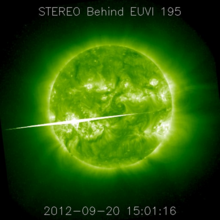news
Submitted on 2024-07-22
Preliminary sunspot numbers during last week were the highest in 22 years.
Submitted on 2024-07-14
NOAA 3738 produced an X1.2 flare on 14 July 2024. ***UPDATED (2)***
Submitted on 2024-07-02
On 20 May, instruments on board Solar Orbiter observed what was most likely the strongest solar flare so far during SC25.
Submitted on 2024-06-25
An impressive eruption took place over the Sun's southwest limb on 24 June.
Submitted on 2024-06-24
The Journal of Space Weather and Space Climate (JSWSC) opens a Topical Issue "Severe space weather events of May 2024 and their impacts".
Submitted on 2024-06-19
The fairly recent Hpo geomagnetic index deals with the two major shortcomings of the Kp index.
Submitted on 2024-06-11
The Journal of Space Weather and Space Climate (JSWSC) opens the Topical Issue “Swarm 10-Year Anniversary”, dedicated to new results from ESA’s Swarm mission, in particular to investigations of the Magnetosphere-Ionosphere Coupling, Ionospheric and Thermospheric processes, and their implications for Space Weather.
Submitted on 2024-06-11
The STCE's SC25 Tracking page has been updated to reflect the latest evolution of some critical space weather parameters for the ongoing solar cycle 25 (SC25).
Submitted on 2024-05-29
Important ionospheric effects over Europe have been observed during the extreme geomagnetic storm of 10 and 11 May.
Pages
Zircon - This is a contributing Drupal Theme
Design by
WeebPal.









































